Bur Dubai
Strung out along the southern side of the Creek, Bur Dubai is the oldest part of the city. Parts of the district’s historic waterfront still retain their engagingly old-fashioned appearance, with a quaint tangle of sand-coloured buildings and a distinctively Arabian skyline, spiked with dozens of wind towers and the occasional minaret. At the heart of the district, the absorbing Dubai Museum offers an excellent introduction to the city’s history, while the old Iranian quarter of Bastakiya is home to the city’s most impressive collection of traditional buildings. Heading west along the Creek, the old-fashioned Textile Souk is the prettiest in the city, while to the north the historic quarter of Shindagha is home to another fine cluster of century-old edifices.

The Creek
Cutting a broad, salty swathe through the middle of the city centre, the Creek (Al Khor in Arabic) lies physically and historically at the very heart of Dubai. The Creek was the location of the earliest settlements in the area – first on the Bur Dubai side of the water, and subsequently in Deira – and also played a crucial role in establishing Dubai as a major port during the twentieth century. Commerce aside, the Creek remains the centrepiece of Dubai and its finest natural feature; a broad, serene stretch of water which is as essential a part of the fabric and texture of the city as the Thames is to London or the Seine to Paris.
The walk along the Bur Dubai waterfront is particularly lovely, pedestrianized throughout, and with cooling breezes and wonderful views of the city down the Creek – particularly beautiful towards sunset. For the best views, begin in Shindagha and head south; it takes about 20–25 minutes to reach Bastakiya. A spacious promenade stretches down the waterfront as far as Shindagha Tower, from where a narrow walkway extends down to the Bur Dubai Abra Station and the Textile Souk.
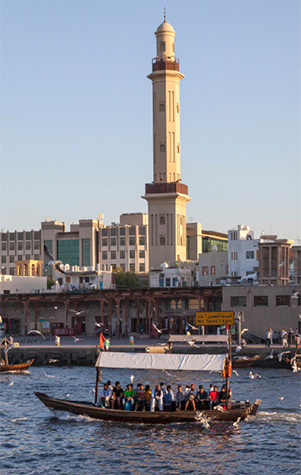
Crossing the Creek by abra
One of the most fun things you can do in Bur Dubai is go for a ride by abra across the Creek – the area’s two main abra stations are the Bur Dubai Abra Station, just outside the main entrance to the Textile Souk, and Bur Dubai Old Souk Abra Station, inside the souk itself, from where these old-fashioned little wooden boats shuttle across the Creek at all hours of the day and night to Deira Old Souk and Al Sabkha abra stations on the other side of the water in Deira. The boats’ basic design has changed little for at least a century, apart from the addition of a diesel engine, and abras still play a crucial role in the city’s transport infrastructure, carrying a staggering twenty million passengers per year for a modest 1dh per trip.
Dubai Museum
At the dead centre of Bur Dubai stands the old Al Fahidi Fort, a rough-and-ready little structure whose engagingly lopsided corner turrets – one square and one round – make it look a bit like a giant sandcastle. Dating from around 1800, the fort is the oldest building in Dubai, having originally been built to defend the town’s landward approaches against raids by rival Bedouin tribes; it also served as the residence and office of the ruling sheikh up until the early twentieth century before being converted into a museum in 1971.
The fort now provides a home for the excellent Dubai Museum, a logical first stop on any tour of the city and the perfect place to get up to speed with the history and culture of the emirate. Entering the museum you step into the fort’s central courtyard, dotted with assorted wooden boats revealing the different types of vessel used in old Dubai, including a traditional abra, not so very different from those still in service on the Creek today. In one corner stands a traditional barasti (or areesh) hut, topped by a basic burlap wind tower – the sort of building most people in Dubai lived in right up until the 1960s. The hut’s walls are made out of neatly cut palm branches, spaced so that breezes are able to blow right through and meaning it stays surprisingly cool even in the heat of the day.
The museum’s real attraction, however, is its sprawling underground section, a buried wonderland which offers as comprehensive an overview of the traditional life, crafts and culture of Dubai as you’ll find anywhere. A sequence of rooms – full of the sound effects and life-size mannequins without which no Dubai museum would be complete – covers every significant aspect of traditional Dubaian life, including Islam, local architecture and wind towers, traditional dress and games, camels and falconry. Interesting short films on various subjects are shown in many of the rooms, including fascinating historic footage of pearl divers at work. There’s also a line of shops featuring various traditional trades and crafts – carpenters, blacksmiths, tailors, spice merchants and so on. It’s kitsch but undeniably engaging, populated with colourful mannequins in traditional dress, although the old black-and-white video clips of artisans at work add a slightly spooky touch.
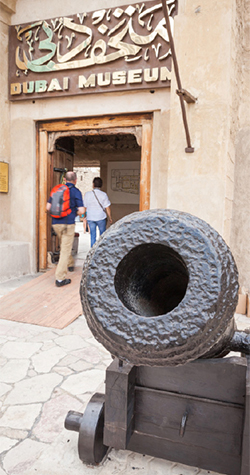
Bastakiya
The beautiful old quarter of Bastakiya comprises a photogenic huddle of traditional Gulf houses, capped with dozens of wind towers and arranged around a rabbit warren of tiny alleyways. The houses here were originally put up in the early 1900s by merchants from southern Iran who named their new suburb Bastakiya after their ancestral home, the Iranian town of Bastak.
A number of old Bastakiya houses have now been opened to the public as small-scale museums and galleries. Best is the Coins Museum, containing a well-presented collection of over four hundred Islamic coins. The Architectural Heritage Department, boasting a particularly large and chintzy courtyard and fine views over Bastakiya from its roof, also repays a quick look. Also worth a visit is the long-running Majlis Gallery, the oldest in the city, founded in 1989 and hosting monthly exhibitions showcasing the work of Emirati and international artists.
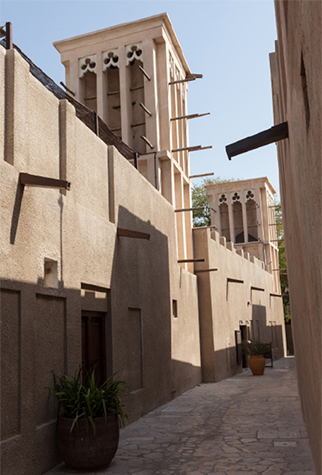
Wind towers
Often described as the world’s oldest form of air-conditioning, the distinctive wind towers (barjeel) that top many old Dubai buildings (as well as numerous modern ones constructed in faux-Arabian style) provided an ingeniously simple way of countering the Gulf’s searing temperatures in a pre-electrical age. Rising around 6m above the rooftops on which they’re built, wind towers are open on all four sides and channel any available breezes down into the building via triangular flues. Bastakiya’s collection of wind towers is the largest and finest in the city, with subtle variations in design from tower to tower, meaning that no two are ever exactly alike.
The SMCCU
Based in an office on the eastern edge of Bastakiya, the pioneering Sheikh Mohammed Centre for Cultural Understanding, or SMCCU, runs popular tours of Jumeirah Mosque and a number of activities in Bastakiya itself, including walking tours, Gulf Arabic classes and “cultural” breakfasts and lunches, during which you get the chance to sample some traditional food while chatting to the centre’s Emirati staff.
The Grand Mosque and Diwan
The biggest in Dubai, the imposing Grand Mosque is an impressively large if rather plain structure, the general austerity relieved only by an elaborate swirl of Koranic script over the entrance and the city’s tallest minaret. Hugging the creekside immediately east of the Grand Mosque sits the Diwan, or Ruler’s Court, now home to assorted government functionaries, and the eye-catching Diwan Mosque, topped by an unusually flattened onion dome and a slender white minaret which rivals that of the nearby Grand Mosque in height.
The Textile Souk
At the heart of Bur Dubai, the Textile Souk (also sometimes referred to as the “Old Souk”) is easily the prettiest in the city, occupying an immaculately restored traditional bazaar, its long line of sand-coloured buildings shaded by a fine arched wooden roof, blissfully cool even in the heat of the day and illuminated by traditional Moorish hanging lights after dark. This was once the most important bazaar in the city although its commercial importance has long since faded and almost all the shops have now been taken over by Indian traders flogging reams of sari cloth and fluorescent blankets, alongside assorted tourist tat (if you’re hankering for an I ♥ DUBAI T-shirt or spangly camel, now’s your chance).
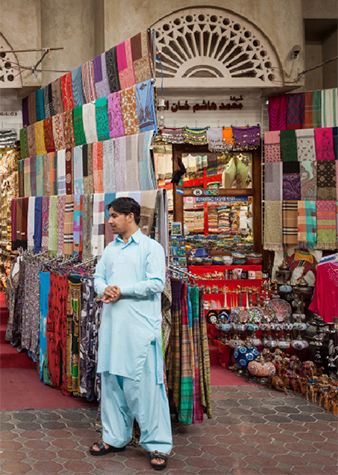
Hindi Lane
The colourful little alleyway popularly known as Hindi Lane is one of Dubai’s most curious and appealing little ethnic enclaves. Walk to the far (eastern) end of the Textile Souk, turn right by T. Singh Trading and then left by Mohammadi Textiles and you’ll find yourself in a tiny alleyway lined with picturesque little Indian shops selling an array of bangles, bindis, coconuts, flowers, bells, almanacs and other religious paraphernalia. On the north side of Hindi Lane is the tiny hybridized Hindu-cum-Sikh temple sometimes referred to as the Sikh Gurudaba, while continuing along Hindi Lane to the back of the Grand Mosque brings you to a second Hindu temple, the Shri Nathje Jayate Temple, dedicated to Krishna.
Iranian mosques
Hidden away on the south side of the Textile Souk are two of the city’s finest Iranian mosques. The more easterly of the two mosques is particularly eye-catching, with a superb facade and dome covered in a lustrous mosaic of predominantly blue tiling decorated with geometrical floral motifs. The second mosque, about 50m west along the road, close to the Time Palace Hotel, is a contrastingly plain, sand-coloured building, its rooftop enlivened by four tightly packed little egg-shaped domes.
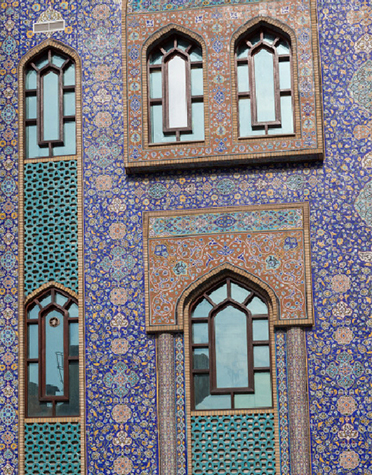
Al Fahidi Street
Al Fahidi Street is Bur Dubai’s de facto high street, lined with a mix of shops selling Indian clothing, shoes and jewellery along with other places stacked high with mobile phones and fancy watches (not necessarily genuine). The eastern end of the street and adjacent Al Hisn Street are also often loosely referred to as Meena Bazaar, the centre of the district’s textile and tailoring industry and home to a dense razzle-dazzle of shopfronts stuffed with sumptuous saris.
Shindagha
Although now effectively swallowed up by Bur Dubai, the historic creekside district of Shindagha was, until fifty years ago, a quite separate and self-contained area occupying its own spit of land, and frequently cut off from Bur Dubai proper during high tides. This was once the most exclusive address in town, home to the ruling family and other local elites, who occupied a series of imposing houses lined up along the waterfront. The edge of the district is guarded by the distinctive waterfront Shindagha Tower, instantly recognizable thanks to the slit windows and protruding buttress on each side, arranged to resemble a human face.
Sheikh Saeed al Maktoum House
Standing on the beautiful Shindagha waterfront, the Sheikh Saeed al Maktoum House is one of Dubai’s most interesting museums, occupying what from 1896 to 1958 was the principal residence of Dubai’s ruling family – an atmospheric wind-towered mansion arranged around a spacious sandy courtyard. Inside, pride of place goes to the superb collection of old photographs, with images of the city from the 1940s through to the late 1960s, showing the first steps in its amazing transformation from a remote Gulf town to global megalopolis.
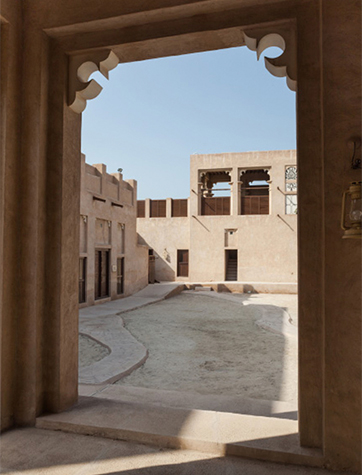
Traditional Architecture Museum
One of the most interesting of the hotchpotch of Shindagha museums, the Traditional Architecture Museum, halfway between Shindagha Tower and Sheikh Saeed al Maktoum House, occupies a rather grand traditional house with the usual sandy courtyard, wind towers and elaborate latticed wall-panels decorated with geometrical and floral patterns moulded from the traditional mix of gypsum, coral, limestone and sand. Inside, informative displays cover the story of architecture in the Emirates generally and Dubai in particular, including insightful explanations of the region’s various different types of building, local materials and construction techniques, accompanied by a good spread of exhibits and the usual life-size mannequins pounding and plastering silently away.
Heritage and Diving Villages
The so-called Heritage Village comprises a string of traditional buildings surrounding a large sandy courtyard, at the back of which are a few souvenir shops. The atmosphere is fairly moribund at most times, but livens up somewhat after dark during national holidays and festivals, particularly Ramadan and the Dubai Shopping Festival, when locals put on cookery and craft displays. The adjacent Diving Village offers more of the same, with further traditional buildings around another courtyard dotted with a couple of wooden boats and a few barasti huts, plus two boat-shaped phone booths – a rather lame tribute to the pearl-diving trade which underpinned the city’s economy up until the 1930s.
Shops
Ajmal
Dubai’s leading perfumiers, offering a wide range of fragrances including traditional attar-based Arabian scents. If you don’t like any of their ready-made perfumes you can make up your own from the big glass bottles on display behind the counter. Other branches at Deira Gold Souk, Khan Murjan, Deira City Centre and Mall of the Emirates.
Bateel Dates
The best dates in the city, grown in Bateel’s own plantations in Saudi Arabia and sold either plain, covered in chocolate or stuffed with ingredients such as almonds and slices of lemon or orange. Other branches at Deira City Centre, Festival Centre, Souk al Bahar and Dubai Mall.
Burjuman
The biggest and best city-centre mall, BurJuman remains popular thanks to its convenient location and 300-plus shops, including the flagship Saks Fifth Avenue department store.
Carrefour
This vast French hypermarket chain might not be the most atmospheric place to shop in the city, but it is one of the best places to pick up just about any kind of Middle Eastern foodstuff you fancy, and is also a good source of cheap electronics, kitchenware, rugs and perfumes. Other branches at Deira City Centre, Mall of the Emirates and Marina Mall.
Dream Girl Tailors
Perhaps the best of the various tailors hereabouts, offering well-made, inexpensive copies of any existing garment you might bring in: around 60dh for a shirt or trousers, or from 150dh for a dress (not including material). They can also make up clothes from photographs or even a hand-drawn design.
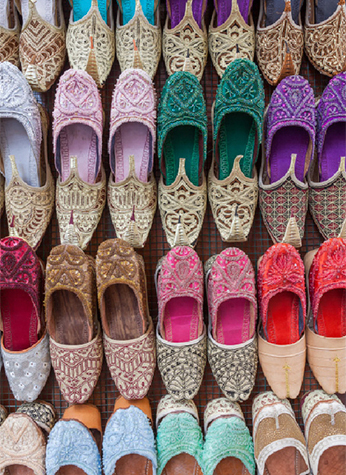
International Aladdin Shoes
Eye-catching little stall (no sign) in the midst of the Textile Souk selling a gorgeous selection of colourful embroidered ladies’ slippers (65–200dh) along with lovely embroidered belts.
Cafés
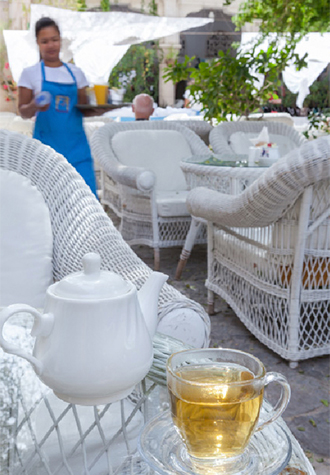
Arabian Tea House Café
Lovely little courtyard café set in the idyllic garden of a traditional old Bastakiya house. The menu features a good range of light meals, plus sandwiches and salads (from 30dh), assorted breakfasts (from 22dh) and decent juices and smoothies.
Bayt al Wakeel
The small menu of rather pedestrian Arabian food (plus a few Chinese options) won’t win any awards, but the convenient location near the entrance to the Textile Souk and the setting on an attractive terrace jutting out into the Creek amply compensate. Mezze 15dh, mains 30–40dh (plus some more expensive seafood dishes 60–75dh).
Dôme
This low-key café is a reliable source of good coffee and cheap grub including pasta, pizzas, soups, salads, burgers and a few more substantial international mains, plus very competitively priced daily specials, with mains for around 27–42dh. Other branches at DIFC, Dubai Mall, Jumaira Plaza, Souk Madinat Jumeirah and Ibn Battuta Mall.
Kan Zaman
Occupying a beautiful creekside location in historic Shindagha, this large Middle Eastern restaurant is one of the best places in the city for a blast of authentic Arabian atmosphere – it’s usually full of local Emiratis and expat Arabs puffing on shisha after dark. Food includes good hot and cold mezze (most under 20dh) plus meat and seafood grills (40dh), and there’s an excellent shisha collection.
XVA Café
Tucked away in an alley at the back of Bastakiya, this shady courtyard café (attached to a lovely guesthouse; see XVA) serves up good vegetarian food including flavoursome salads and sandwiches (22–33dh) and assorted light meals (33–38dh) with a Middle Eastern twist – tabbouleh or burghul salads, for example, or halloumi and cucumber sandwiches – plus good breakfasts.
Restaurants
Antique Bazaar
This pretty little restaurant, littered with assorted subcontinental artefacts, dishes up a fair selection of North Indian favourites with reasonable aplomb. There’s also a decent resident band and dancers nightly from 9pm. Mains from around 40dh (veg), 50–55dh (meat).
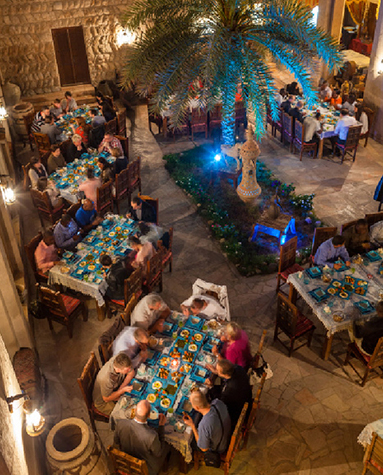
Bastakiah Nights
One of the most beautiful places to eat in central Dubai, occupying a superbly restored old house in Bastakiya. The Middle Eastern food (mains 45–70dh) doesn’t quite match up, though when the setting’s this good you might not care.
Yakitori-tei
Though this modern establishment lacks a bit of character, its mainly Japanese menu (mains mostly 55–85dh) ticks all the usual boxes, with decent stir-fries, sushi, sashimi, maki, yakitori and curries. There’s also a cursory list of Thai classics and jugs of draught sake to wash it all down with.
Bars
Sherlock Holmes
One of the better pubs hereabouts, with a relaxed atmosphere, flock wallpaper and glass cases full of vaguely Sherlock Holmes-related memorabilia – although noisy live music sometimes intrudes. Also does decent pub food.
Viceroy Bar
This traditional English-style pub is the nicest in Bur Dubai, complete with fake oak-beamed ceiling, authentic wooden bar and oodles of comfy leather armchairs.
Club
Velvet Underground
Bringing a dash of club culture to deepest Bur Dubai, Velvet Underground serves up an eclectic mix of music ranging from hip-hop and r’n’b through to Bollywood, Arabic and African. Free before midnight, after which men pay 100dh.